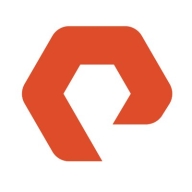


Red Hat Ceph Storage and IBM Spectrum Accelerate compete in scalable and reliable storage solutions. Despite Red Hat Ceph's advantage in pricing and support, IBM Spectrum Accelerate is preferred for advanced features.
Features: Red Hat Ceph Storage provides scalable block and object storage, strong integration, and suitability for diverse workloads. IBM Spectrum Accelerate offers high performance, advanced data management, and is optimized for enterprise environments.
Ease of Deployment and Customer Service: Red Hat Ceph Storage features a flexible deployment model and comprehensive support for easy integration. IBM Spectrum Accelerate is more complex to deploy but offers robust customer service for seamless implementation.
Pricing and ROI: Red Hat Ceph Storage is cost-effective, providing positive ROI appealing to budget-conscious organizations. IBM Spectrum Accelerate requires a higher initial investment but delivers substantial ROI through its feature-rich platform.
| Product | Market Share (%) |
|---|---|
| Red Hat Ceph Storage | 18.4% |
| Pure Storage FlashBlade | 4.1% |
| IBM Spectrum Accelerate | 2.0% |
| Other | 75.5% |


| Company Size | Count |
|---|---|
| Small Business | 11 |
| Midsize Enterprise | 11 |
| Large Enterprise | 20 |
| Company Size | Count |
|---|---|
| Small Business | 13 |
| Midsize Enterprise | 4 |
| Large Enterprise | 15 |
FlashBlade is the industry’s most advanced scale-out storage for unstructured data, powered by a modern, massively parallel architecture to consolidate complex data silos (like backup appliances and data lakes) and accelerate tomorrow’s discoveries and insights.
IBM Spectrum Accelerate is a software-defined block storage solution designed for rapid deployment across heterogeneous infrastructure for hybrid cloud and delivering consistent service levels to a dynamic workload mix. It is based on proven grid-architecture, enterprise-scale IBM XIV technology. IBM Spectrum Accelerate can be deployed, including as hyper-converged infrastructure, on any x86 server, on pre-installed third-party appliances or on public cloud infrastructure, and is available as a service on IBM Cloud infrastructure.
We monitor all Software Defined Storage (SDS) reviews to prevent fraudulent reviews and keep review quality high. We do not post reviews by company employees or direct competitors. We validate each review for authenticity via cross-reference with LinkedIn, and personal follow-up with the reviewer when necessary.